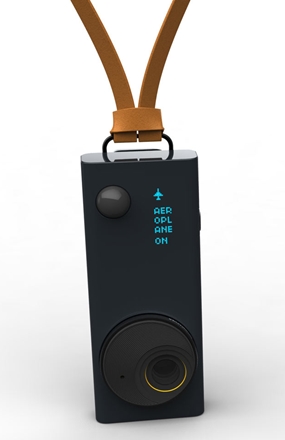I have to admit that when digital cameras first came out, I pooh poohed the notion. They would never be as good as ‘proper’ film cameras. Another geek idea of little value to the real world. I was wrong.
And when I think of technology and its effects upon us, I will let you into another secret skeleton in the family cupboard – I only bought my first fax machine because I was embarrassed by people asking me for my fax number. I could see no way I could use it! Wrong again. Mind you, I’m not as bad as David Ogilvy (Ogilvy and Mather Advertising Agency) who turned down the Xerox contract as he couldn’t see that the company had any future, just copying things!

So after that lead-in, here is the Autographer, another development of technology, and another which I think has a very limited usefulness. The Autographer is a camera you wear which automatically decides when to take photos as you go about your daily chores.
The Autographer uses its six on-board sensors (GPS, color, accelerometer, motion detector, magnetometer and thermometer) – to gather data. The data from its six sensors is then read by software developed by Microsoft (yes, the press ‘Start to Stop’ people) that chooses the best moment to capture an image without any intervention from you. Quite frankly, when I read that it takes high-resolution pictures, which can be 2,000 in a day, and then it can combine them all to create a visual record of an event like a party, a music festival or a typical day in the life of the owner. With that description, I wonder whether or not all that software is redundant. 2000 photos, in let us say a 10 hour day, works out that your wearable Autographer is taking a photo every 18 seconds during your day. (I hope it can be turned off when you go to the loo!)
The sensor is not so large in these days of 20 plus megapixels, being only five megapixels but the lens has a field of vision of 136 degrees. “We’ve spent a lot of time developing our wide-angle eye-view lens which is at the heart of the Autographer’s story-telling ability. It gives a unique first-person perspective that allows the wearer to “tell their story uninhibited as they see it,” or so says the manufacturer.
However, here comes the technology of today – it can connect to smartphones via Bluetooth or computer via USB cable, OLED display, 8GB of on-board storage and there is also a shutter button on the side of the Autographer to allow you to manually over-ride and decide when you want the shot to be taken.
As opposed to cameras you hold, this photographic “device” can be worn around your neck, like the medallions or pendants, clipped to clothing or placed in a particular vantage point, is the first consumer device from British company OMG (Oxford Metrics Group and not Oh My God), whose stop-motion technology is used in fields ranging from computer game development to surveying roads.
OMG said it originally developed a version of the Autographer as a memory aid for people with dementia, but said it decided to launch it to the broader market after finding users and their families were also using the devices to record and remember special occasions.
OMG chief executive Nick Bolton said the camera occupied a space between stills photography and video. “It can capture really meaningful single images, but there’s actually something about watching the day back in sequence,” Bolton said. “It tells a story about the day you’ve just experienced.”
The blurb claims “Autographer doesn’t just effortlessly capture images, it captures stories. This offers limitless possibilities for ‘creatives’ and professionals too. As the device is hands-free and wearable, it’s more versatile than a traditional camera in many circumstances; it’s only limited by the imagination of the wearer.”
That means the company thinks it should appeal to anyone interested in recording an event without having to operate a camera, or as an additional tool for documentary photographers.
It will go on sale in November from the company’s website for £399.
You can read more: http://www.smh.com.au/digital-life/cameras/smile-please-clickfree-camera-takes-photos-for-you-20120925-26i2y.html#ixzz27XB0t45N




